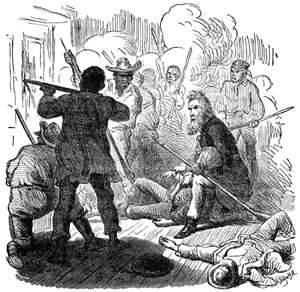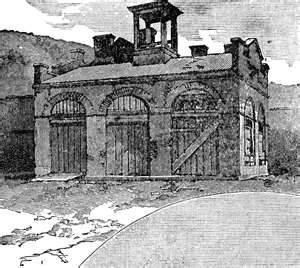John Brown's raid on the federal arsenal at Harpers Ferry didn't have the specific results that Brown intended, but it did provide both North and South with rallying cries for the deepening conflict that soon became the Civil War. Harpers Ferry, Va., had been the site of one of two national armories since 1794. (The other was in Springfield, Mass., near where Brown grew up.) President George Washington had chosen the Harpers Ferry site in part because of its proximity to two rivers, the Potomac and the Shenandoah. A further military focus came in 1817, when the American government entered into an agreement with gunmaker John H. Hall to make rifles at Harpers Ferry. So the appeal for John Brown was the seizure of both the armories and the weapons.
Brown put the men through military training for a few weeks. Then, it was time to act. On October 16, Brown and his men marched into Harpers Ferry. Meeting little resistance, since the need for heavy security wasn't thought to be necessary, Brown and his men seized control of the armories and the weapons. The success of Brown's plan depended on the men's ability to escape with the weapons. To help in this goal, Brown's men cut the telegraph lines in the area. However, as they were getting away, they stopped a Baltimore & Ohio train and, after holding its crew and passengers for five hours, let it continue on to Baltimore. The conductor got word to the federal government, and federal troops were dispatched. Brown's overall plan was to distribute the weapons to escaped slaves, with the ultimate goal being an armed slaved rebellion. He had hoped to establish a base in the Blue Ridge Mountains and augment his work on the Underground Railroad with helping to arm slaves so they could resist capture or even fight back against their former masters. But even local slaves didn't respond to Brown's call. Further, Brown and his men didn't make it out of the armory before the federal troops arrived, in part because local militiamen refused to let them leave.
A company of Marines commanded by Robert E. Lee (who would go on to become a general in the Confederate Army) surrounded the building where Brown and his men were hiding and then stormed in. Ten of Brown's men were killed, and seven (including Brown) were captured. The rest escaped. During the capture, Brown was hurt by a soldier wielding a sword. Still recovering from the sword wound, Brown stood trial a week later and was found guilty of treason. He was sentenced to death and was hanged on December 2, in Charles Town. A few of his followers were also convicted and executed. Brown's trial and execution made him more famous than his earlier violent exploits. The statement he made just before he was hanged was widely quoted and printed in newspapers across the country. Although many people condemned his violent actions, they applauded the sentiments behind them. The raid on Harpers Ferry is often thought as one of the tinderboxes of the Civil War. |
|
Social Studies for Kids
copyright 2002–2026
David White

 In 1859, during the summer, Brown and three of his sons joined nearly two dozen other men at a farm in Maryland, near Harpers Ferry. Brown was at the time using another name, Isaac Smith.
In 1859, during the summer, Brown and three of his sons joined nearly two dozen other men at a farm in Maryland, near Harpers Ferry. Brown was at the time using another name, Isaac Smith. Brown and his men ended up in one building, which later came to be called John Brown's Fort. It was there that they were finally confronted.
Brown and his men ended up in one building, which later came to be called John Brown's Fort. It was there that they were finally confronted.
